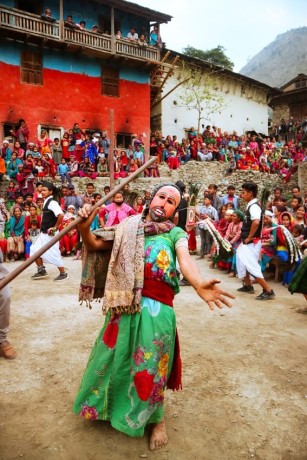Unveiling the Rich Tapestry of the Magar Caste: A Journey Through History, Culture, and Identity Professional
Aug 22nd, 2023 at 10:31 Blogs Kathmandu 0.9K views Reference: 694Location: Kathmandu
Price: Contact us
Unveiling the Rich Tapestry of the Magar Caste: A Journey Through History, Culture, and Identity
IntroductionNepal, nestled in the Himalayas, is a country renowned for its stunning landscapes and diverse cultural heritage. Among the mosaic of ethnic groups that call this nation home, the Magar caste holds a unique and compelling place. With a history that spans centuries and a culture rich in tradition, the Magars have played a significant role in shaping the social, cultural, and historical landscape of Nepal. In this exploration, we delve deep into the heart of the Magar community, unraveling their history, culture, and the challenges they face in the modern world.
Historical OriginsThe Magar people, also known as 'Mangar,' are one of the indigenous ethnic groups of Nepal. Their history can be traced back to ancient times, with references to their presence in Nepalese history dating as far back as the Licchavi period (c. 400-750 AD). This enduring presence highlights their deep-rooted connection to the land and their contributions to the country's historical development. One theory suggests that the name 'Magar' is derived from 'Magaras,' which means 'warrior' in Sanskrit, emphasizing their historical martial prowess. Over the centuries, the Magars have inhabited various regions of Nepal, with significant populations in the western and central regions of the country. Their adaptability and resilience allowed them to thrive in diverse geographical conditions, from the rugged hills to the fertile plains.
Cultural Riches of the MagarsThe Magar culture is a treasure trove of traditions, customs, and artistic expressions that reflect their unique identity. Here are some key aspects of Magar culture:
Language: The Magar people have their own language, known as 'Kham,' which belongs to the Sino-Tibetan language family. Despite the dominance of Nepali as the national language, efforts are being made to preserve and promote the Magar language to ensure its survival.
Religion and Spirituality: The majority of Magars adhere to a combination of indigenous animistic beliefs and Hinduism. Nature plays a significant role in their spiritual practices, and they have their own rituals, festivals, and shamans who connect with the spirit world.
Traditional Attire: The traditional dress of Magar men includes a 'Gunyu Cholo' or 'Daura Suruwal,' which is a knee-length shirt and trousers combination. Women wear a 'Gunyu Cholo' or 'Gunyu Bhale,' a colorful outfit with intricate designs. These attires are not only symbols of their cultural identity but also reflect the geography and climate of their regions.Agriculture: Agriculture is a primary occupation for many Magar families. They cultivate crops such as rice, maize, millet, and vegetables in the fertile valleys and terraced fields of the hilly regions.Social Structure: The Magar community traditionally had its own unique social hierarchy, with clear distinctions among different clans and lineages. However, over time, this hierarchy has become less rigid, especially in urban areas, as modernization and education have brought about social change.
Challenges Faced by the Magar CommunityWhile the Magar community boasts a rich cultural heritage, they also face a set of challenges that impact their socio-economic development. These challenges include:
Healthcare Access: Access to healthcare services is another pressing issue, especially in remote Magar communities. Limited healthcare infrastructure and awareness of healthcare practices can lead to preventable health problems.
Cultural Erosion: The influx of modernization and urbanization is gradually eroding some aspects of Magar culture. Younger generations are increasingly exposed to Western influences, which can lead to a decline in the practice of traditional customs and rituals
Land Rights: Land ownership and access to natural resources remain contentious issues for the Magar community. Land disputes, landlessness, and unequal land distribution are recurring problems that need addressing.
Progress and ResilienceDespite these challenges, the Magar community is not standing still. Efforts are being made by various individuals and organizations to empower the Magar people and preserve their unique heritage. Some of these initiatives include:Education Initiatives: NGOs and government programs are working to improve access to education in Magar-majority areas. Scholarships, literacy programs, and the establishment of schools are helping to bridge the educational gap.Economic Empowerment: Microfinance initiatives and vocational training programs are being introduced to enhance the economic prospects of Magar communities. These initiatives aim to improve income generation and reduce economic disparities.Cultural Preservation: Cultural organizations and community leaders are actively involved in preserving and promoting Magar culture. Festivals, cultural exhibitions, and language classes are being organized to ensure the transmission of cultural knowledge to younger generations.Healthcare Access: Efforts are being made to improve healthcare infrastructure in Magar-majority areas, with a focus on preventive healthcare and awareness campaigns.Land Reforms: Advocacy for land rights and land redistribution is ongoing, with the aim of addressing the issue of landlessness and ensuring equitable access to natural resources.
ConclusionThe Magar caste, with its deep-rooted history and vibrant culture, is an integral part of Nepal's diverse social fabric. Their journey through time has been marked by resilience and adaptability, enabling them to thrive in challenging environments. While they face contemporary challenges such as limited educational opportunities and economic marginalization, the Magar community is actively working to overcome these obstacles and preserve their unique cultural heritage.







Good information